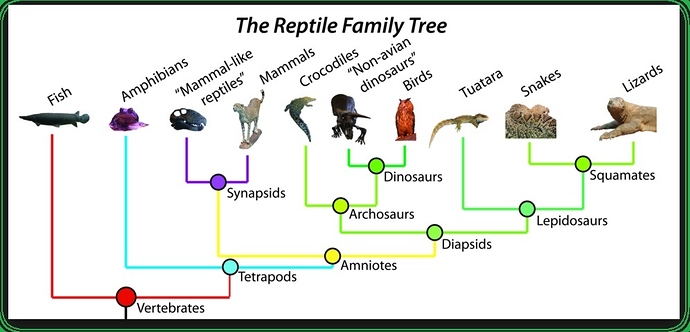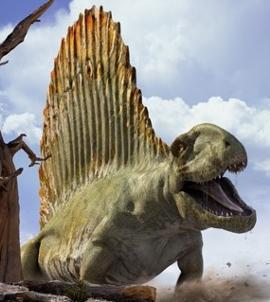Martin,
If you read about the history of biology, scientists assign names to creatures that reference key traits that distinguish the animal from near relatives.
Here’s the BIG picture about the Evolution of life onto dry land:
FIRST - THE TETRAPODS - 4 Limbed creatures with backbones.
Tetrapods evolved from the lobe-finned fishes around 390 million years ago. (Coelacanths and Lungfish (like Salamanderfish).
The first branch of Tetrapods were Anam-niotes:
Fishes & Amphibians (eg., Frogs). Eggs must be laid in water.
Then there were the Amniotes:
Characterized by having an egg equipped with an amnios, an adaptation to lay eggs on land. These were the first Reptiles.
There were four types of Amniote skull, classified by the number and location of their fenestra. These are:
[1] Anapsida –
no openings in the skull. Some turtles are examples of Anapsids.
[2] Synapsida –
one low opening (beneath the postorbital and squamosal bones). The dinosaur-LIKE creature with a giant sail was the Dimetrodon. Synapsida are easily separated from other amniotes by having a temporal fenestra, an opening low in the skull roof behind each eye, leaving a bony arch beneath each; this accounts for their name. Synapsids were considered to be the reptilian lineage that led to mammals.
[3] Diapsida –
two openings. The diapsids are extremely diverse, and include all
3a. lizards,
3b. snakes,
3c. tuatara, (Only surviving types of lizard-like creatures are on New Zealand).
3d. birds and
3e. non-avian dinosaurs (including the Archosaurs, which included 3 groups: the Crocodyl-omorphs, the Pterosaurs (flying reptiles), and the Dinosaurs.)
[4] Euryapsida –
one high opening (above the postorbital and squamosal bones); euryapsids actually evolved from a diapsid configuration, losing their lower temporal fenestra. This interesting lineage is best represented by two famous marine reptiles - - Ichthyosaurs and Plesiosaurs plus some turtle like lineages.
Within the Synapsida were Pelycosaur,
like the sail-backed Dimetrodon.
**From the Pelycosaurs, the Therapsids emerged - **
in the Middle Permian, about 265 million years ago, and became the dominant land vertebrates. These more resourceful group, the Therapsids, were a diverse group of fanged, ugly animals that look like a cross between rats and lizards.
From these came the mammals.
1) Monotremes (Egg-laying mammals like the Platypus);
2) The Viviparous, giving birth to live young.
2a) Marsupials (mammals with pouches);
2b) Placentals
"True placental mammals … arose from at least the Middle Jurassic period, about 170 MYA). These early Eutherians were small, nocturnal insect eaters, with adaptations for life in trees. True placentals probably originated in the Late Cretaceous around 90 MYA, but the earliest undisputed fossils are from the early Paleocene, 66 MYA, following the disappearance of the dinosaurs. Modern members of the placental orders originated in the Paleogene around 66 to 23 MYA, following the extinction of the dinosaurs.
Within the Placentals,
there was the smaller sized “Tree Shrew” like animals,
and a group called
Primato-morpha… the start of the monkey-like creatures.
Branching off from the Primato-morpha were the
Colugos (gliding primates).
And the other branch eventually emerged as
the Primates.
Primates included
the Lemurs,
the true Monkeys (old world and new world),
the Gibbons,
the Great Apes (Chimps & Gorillas),
and finally Hominids.
There are lots of other kinds of animals that this listing glosses over … this outline is meant simply to quickly present the major branches within Tetrapods… and how we eventually ended up with mammals… then primate mammals… and finally the hominids of the primate mammals.
George

